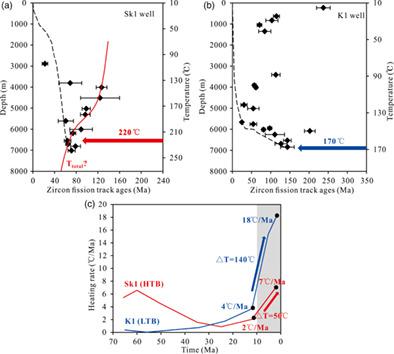当前位置:
X-MOL 学术
›
Geolog. J.
›
论文详情
Our official English website, www.x-mol.net, welcomes your
feedback! (Note: you will need to create a separate account there.)
Study on the detrital zircon fission-track ages from natural borehole samples in the Bohai Bay and Tarim basins with different thermal backgrounds
Geological Journal ( IF 1.4 ) Pub Date : 2021-04-26 , DOI: 10.1002/gj.4158 Chang'e Cai 1, 2 , Nansheng Qiu 2 , Cleber Jose Soares 3 , Hong Chen 1
Geological Journal ( IF 1.4 ) Pub Date : 2021-04-26 , DOI: 10.1002/gj.4158 Chang'e Cai 1, 2 , Nansheng Qiu 2 , Cleber Jose Soares 3 , Hong Chen 1
Affiliation

|
Zircon fission-track thermochronometry was used as an effective indicator to investigate the thermal history of sedimentary basins with high temperatures, and fission-track ages and annealing temperatures were very important parameters. We measured fission-track ages and discussed the annealing behaviour of zircon fission track from natural borehole samples in the Bohai Bay and Tarim basins. The annealing temperature of the zircon fission track was approximately 220°C in the deep borehole samples of the Bohai Bay Basin with a high thermal background. However, the annealing temperature was approximately 170°C in the deep borehole samples of the Tarim Basin with a low thermal background. In Neogene–Quaternary, the heating rate ranged from 2 to 7°C/Ma in the Sk1 samples, and 4 to 18°C/Ma in the K1 samples. This explained that zircon fission track with different thermal backgrounds existed different annealing temperatures due to the different heating rates. The uranium concentration of the K1 samples mostly ranged from 16 to 1,500 ppm, with a few grains spread from >1,500 to 3,000 ppm, while the Sk1 samples mainly distributed between 4 ppm and 350 ppm. The K1 samples with high uranium contents tended to accumulate much radiation damages and were less resistant to annealing and appeared to have a lower annealing temperature compared to zircons of lower uranium contents in the Sk1 samples. By properly understanding annealing behaviour and annealing temperature, zircon fission-track thermochronometry could provide a correct explanation for fission-track ages.
中文翻译:

渤海湾和塔里木盆地不同热背景天然钻孔样品碎屑锆石裂变径迹年龄研究
锆石裂变径热测年作为研究高温沉积盆地热史的有效指标,裂变径龄和退火温度是非常重要的参数。我们测量了裂变径迹年龄并讨论了来自渤海湾和塔里木盆地天然钻孔样品的锆石裂变径迹的退火行为。在热背景较高的渤海湾盆地深钻孔样品中,锆石裂变径迹的退火温度约为220℃。然而,塔里木盆地深井样品的退火温度约为 170°C,热背景较低。在新近纪-第四纪,Sk1 样品的升温速率为 2~7°C/Ma,K1 样品的升温速率为 4~18°C/Ma。这解释了不同热背景的锆石裂变径迹由于加热速率不同而存在不同的退火温度。K1 样品的铀浓度大多在 16 至 1,500 ppm 之间,少数颗粒分布在 > 1,500 至 3,000 ppm 之间,而 Sk1 样品主要分布在 4 ppm 至 350 ppm 之间。与 Sk1 样品中铀含量较低的锆石相比,铀含量高的 K1 样品往往会积累大量辐射损伤,并且对退火的抵抗力较差,并且似乎具有较低的退火温度。通过正确理解退火行为和退火温度,锆石裂变径迹热计时可以为裂变径迹年龄提供正确的解释。
更新日期:2021-04-26
中文翻译:

渤海湾和塔里木盆地不同热背景天然钻孔样品碎屑锆石裂变径迹年龄研究
锆石裂变径热测年作为研究高温沉积盆地热史的有效指标,裂变径龄和退火温度是非常重要的参数。我们测量了裂变径迹年龄并讨论了来自渤海湾和塔里木盆地天然钻孔样品的锆石裂变径迹的退火行为。在热背景较高的渤海湾盆地深钻孔样品中,锆石裂变径迹的退火温度约为220℃。然而,塔里木盆地深井样品的退火温度约为 170°C,热背景较低。在新近纪-第四纪,Sk1 样品的升温速率为 2~7°C/Ma,K1 样品的升温速率为 4~18°C/Ma。这解释了不同热背景的锆石裂变径迹由于加热速率不同而存在不同的退火温度。K1 样品的铀浓度大多在 16 至 1,500 ppm 之间,少数颗粒分布在 > 1,500 至 3,000 ppm 之间,而 Sk1 样品主要分布在 4 ppm 至 350 ppm 之间。与 Sk1 样品中铀含量较低的锆石相比,铀含量高的 K1 样品往往会积累大量辐射损伤,并且对退火的抵抗力较差,并且似乎具有较低的退火温度。通过正确理解退火行为和退火温度,锆石裂变径迹热计时可以为裂变径迹年龄提供正确的解释。











































 京公网安备 11010802027423号
京公网安备 11010802027423号